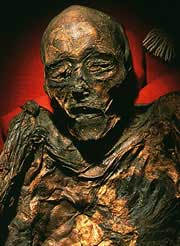Virtual-reality mummy

Until recently, the only way to get inside a mummy was to unwrap it <br>© SPL <br>
Technology unravels mysteries of ancient corpse.
Glassy-eyed with a hole in the head – meet Nesperennub, the virtual-reality mummy. A new three-dimensional reconstruction of his insides swoops through musty layers of linen to penetrate his holy skull, without putting the ancient artefact at risk.
Egyptologist John Taylor smuggled the British Museum’s sealed coffin into a hospital computerized tomography (CT or CAT) scanner after hours. The resulting 1,500 flat scans have now been pieced together to create the first interactive virtual-reality mummy. “It’s pretty exciting,” says Taylor. The project was premiered at a summit on 3D visualization in Glasgow, UK, last week.
“It’s technology meets archaeology,” says David Hughes of high-performance computing company SGI. They provided the powerful hardware and specially built software to manipulate the gigabyte of data churned out by the CAT scans.
The idea to work on the mummy evolved from, and used similar techniques to, the Visible Human Project, a 3D reconstruction of slices through a human body.
The new software reveals surface textures – users can roam freely and zoom in to any feature using an interactive magnifying facility called volume revving. “You can see the pieces of grit in the clay,” marvels Hughes, and even the impression left by nerve endings under Nesperennub’s skull.
In the 1960s, X-rays showed something like a cap over Nesperennub’s head. It was thought to be his placenta, saved since birth for luck. But the new graphics reveal it to be a clay bowl, the purpose of which remains “a very puzzling thing”, says Taylor. Zooming inside the skull reveals a small hole in his temple, which may be connected to his death.
Until recently, the only way to get inside a mummy was to unwrap it. But this popular nineteenth-century parlour activity makes tissues disintegrate. “A huge amount of data was lost,” says Taylor. Simple X-rays are hard to interpret, as solid resin and hard-packed earth inside the corpse are difficult to penetrate.
Using the new visualization technique, archaeologists keen to learn about ancient Egyptians’ appearance and health can reconstruct any body part they like. Taylor plans to build a physical model of the skull and get a picture of Nesperennub’s face. Ultimately, the team hopes to put the reconstruction on public display in the British Museum and other museums worldwide.
It’s a wrap
Nesperennub was a good candidate for internal exploration, as a lot is known about his origins. Hieroglyphics and paintings on the coffin reveal that he was a priest around 800 BC, at the temple of Karnak in the ancient city of Thebes, the forerunner of modern-day Luxor.
He was buried near the Valley of the Kings on the banks of the Nile, and was brought to the British Museum in 1899, probably by travellers or diplomats. A modern ban on the export of antiquities from Egypt means that museums’ mummies are a finite resource.
During the 70-day mummification process, internal organs, except the heart, were usually removed from the body. A rectangular plate covers the incision where they were scraped out of Nesperennub. Like other mummies, he peers through glass fake eyes, inserted by embalmers to ensure that he could see in the afterlife.
Dried with salts and coated with resins and oils to prevent deterioration, the body was then wrapped in linen cloths, alongside a protective winged amulet.
Media Contact
All latest news from the category: Interdisciplinary Research
News and developments from the field of interdisciplinary research.
Among other topics, you can find stimulating reports and articles related to microsystems, emotions research, futures research and stratospheric research.
Newest articles

Silicon Carbide Innovation Alliance to drive industrial-scale semiconductor work
Known for its ability to withstand extreme environments and high voltages, silicon carbide (SiC) is a semiconducting material made up of silicon and carbon atoms arranged into crystals that is…

New SPECT/CT technique shows impressive biomarker identification
…offers increased access for prostate cancer patients. A novel SPECT/CT acquisition method can accurately detect radiopharmaceutical biodistribution in a convenient manner for prostate cancer patients, opening the door for more…

How 3D printers can give robots a soft touch
Soft skin coverings and touch sensors have emerged as a promising feature for robots that are both safer and more intuitive for human interaction, but they are expensive and difficult…





















